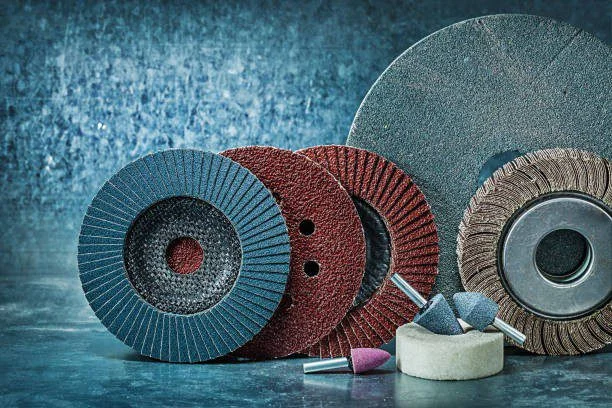Introduction
Carborundum abrasives, also known as silicon carbide abrasives, are widely recognized for their durability and efficiency in various grinding and polishing applications. Made from silicon carbide, one of the hardest materials known to man, these abrasives are used in many industries, from metalworking to ceramics. In this blog, we'll explore the different types of carborundum abrasives, their applications, and the many benefits they offer.

What Are Carborundum Abrasives?
Carborundum abrasives are grinding and polishing materials made from silicon carbide (SiC). Silicon carbide is produced by heating a mixture of sand and carbon at extremely high temperatures, resulting in a hard, sharp material that is ideal for use in grinding wheels, sandpapers, and other abrasive products. These abrasives are typically black or green, with green silicon carbide being the hardest and most durable variant.
Types of Carborundum Abrasives
Carborundum abrasives come in various forms, each designed for specific applications. Here are the most common types:
- Carborundum Grinding Wheels: These are used for grinding metals, ceramics, and other hard materials. Available in different shapes and sizes, carborundum grinding wheels are ideal for both rough grinding and precision finishing.
- Carborundum Sandpaper: Often used for sanding wood, metal, and even stone, carborundum sandpaper comes in various grits. Coarser grits are suitable for removing larger amounts of material, while finer grits are perfect for smooth finishes.
- Carborundum Polishing Stones: These stones are perfect for polishing metal surfaces and removing burrs or sharp edges from metalworking projects.
- Carborundum Abrasive Blasting Media: Used for sandblasting and abrasive blasting applications, carborundum abrasive blasting media helps clean and prepare surfaces for coating or finishing.
Applications of Carborundum Abrasives
Carborundum abrasives are versatile and can be used in a variety of industries. Here are some of the most common applications:
- Metalworking: In metalworking, carborundum abrasives are used for grinding, cutting, and polishing metals like steel, aluminum, and cast iron. Their high hardness makes them perfect for shaping, sharpening tools, and smoothing rough edges.
- Ceramics and Glass Manufacturing: Carborundum abrasives are commonly used in the ceramics and glass industries for grinding and polishing delicate materials. Their ability to handle high temperatures and abrasive resistance makes them ideal for these applications.
- Automotive and Aerospace Industries: These abrasives are crucial in the automotive and aerospace industries for tasks such as engine part grinding, surface preparation, and component polishing. Their consistency and durability ensure long-lasting results.
- Construction and Stone Processing: Carborundum abrasives are often employed in the construction industry for cutting and polishing stone, concrete, and masonry materials. They are especially useful in projects that require high precision and smooth finishes.
Benefits of Using Carborundum Abrasives
There are several key benefits to using carborundum abrasives in various industrial applications:
- Durability: Carborundum abrasives are known for their exceptional durability. The silicon carbide structure allows them to withstand the wear and tear of heavy-duty applications, making them more cost-effective over time.
- High Grinding Efficiency: Due to the hardness and sharpness of silicon carbide, carborundum abrasives provide fast cutting and grinding action, making them efficient for demanding tasks.
- Versatility: Whether you're working with metal, stone, ceramics, or wood, carborundum abrasives are suitable for a wide range of materials. Their adaptability makes them essential tools for many industries.
- Resistance to Heat and Chemicals: Carborundum abrasives can withstand high temperatures and resist chemical reactions, making them ideal for high-performance applications in industries such as metalworking and automotive.
- Fine Surface Finish: With the right grit selection, carborundum abrasives can produce a fine, smooth surface, ideal for polishing and finishing applications.
How to Choose the Right Carborundum Abrasive
When selecting carborundum abrasives, consider the following factors:
- Material Type: Different abrasives are suitable for different materials. For example, harder abrasives are better suited for metals, while softer abrasives are better for ceramics and wood.
- Grit Size: The finer the grit, the smoother the finish. Choose coarser grits for heavy-duty grinding and finer grits for polishing or finishing tasks.
- Abrasive Shape: Depending on the task, you may need different shapes. Grinding wheels are used for rough grinding, while sandpaper and polishing stones are used for finer finishing.
- Application Environment: Consider whether the abrasive will be used in a wet or dry environment, and choose accordingly.
Conclusion
Carborundum abrasives, made from silicon carbide, are some of the most versatile and durable materials available for grinding, polishing, and surface preparation. From the metalworking industry to stone and ceramic manufacturing, their applications are vast and their benefits numerous. By understanding the different types of carborundum abrasives, their uses, and how to choose the right one, you can ensure optimal results for your projects.
If you're looking for the right abrasive for your next job, be sure to explore the variety of carborundum abrasives available. With their efficiency, durability, and versatility, they’re an excellent choice for a wide range of industrial applications.
FAQs
Q: What is the difference between carborundum abrasives and other types of abrasives?
A: Carborundum abrasives are made from silicon carbide, which is harder and more durable than many other abrasives like aluminum oxide, making them ideal for high-performance grinding and polishing tasks.
Q: Can carborundum abrasives be used on soft materials like wood?
A: Yes, carborundum abrasives can be used on softer materials like wood, but for such applications, it’s important to select the right grit to avoid excessive wear.
Q: How do I know which grit to use for my project?
A: Coarse grits (e.g., 40-60) are ideal for removing large amounts of material, while finer grits (e.g., 120-400) are better suited for smoothing surfaces and finishing tasks.
Ready to Try Carborundum Abrasives?
Explore our wide range of carborundum abrasives and find the perfect solution for your grinding, polishing, or cutting needs. Whether you're in metalworking, ceramics, or construction, we have the right abrasive for the job.

